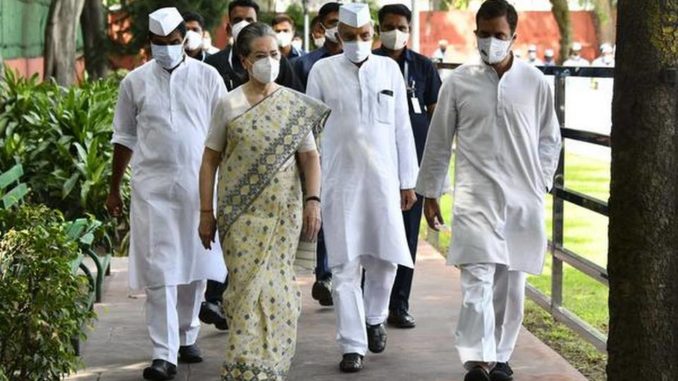

“The strategic shift must involve a reordering of the institutional structures of the party. But very little has been done in the realm of organizational restructuring to broad base the party and revive intra-party democracy. This is partly because the focal point of the leadership of the Gandhis was not and has not been on party building. Doubts about party regeneration in the past had led to a greater reliance on the government and welfare programs for winning support than on reforming the party to mobilize the electorate. The response of the leadership to most fundamental issues was generally governmental rather than political. The lack of organizational heft was a severe limitation hampering its ability to reap the political dividends that could have accrued to the party from the unprecedented welfare spending by the UPA government. Organizational decline has impeded its capacity to engage with mass politics. This remains unchanged even when the party is in opposition.”
The judgment by contemporary writers of Congress leader Rahul Gandhi’s leadership is almost uniformly harsh and unforgiving. It is common to contrast the strength of the formal organization and leadership of the ruling Bharatiya Janata Party (BJP) with the deterioration and decay of the Congress party, especially the central leadership’s failure to reverse this downslide. The contrast between the Congress and the BJP is stark, not in terms of decision-making, which is centralized in both cases, but in terms of overall political management.
The Congress party faces three major challenges — it has to elect a leader capable of keeping the party united, reconstruct its organizational structure across the States, and project and propagate a clear alternative ideological narrative to the BJP. These challenges are more apparent after the 2019 debacle in the general election and the leadership vacuum following Mr. Gandhi’s resignation as president and the party’s abject failure to elect a president to replace him.
Signs of changes
The fallout of Navjot Singh Sidhu’s resignation as State Congress chief in Punjab almost 72 days after he was ‘undeservingly’ appointed to that post has exposed the fault lines in the party. While criticism by the media, the BJP and other Opposition politicians was on predictable lines, the absence of debate and consultation in the party regarding leadership change in Punjab just months ahead of the next Assembly elections (early next year) is a matter of wider concern.
Even though there is no perceptible effort to rebuild the organization and institute formal leadership at various levels, there is a noticeable effort to revive the party through ideological changes pushed by Mr. Gandhi. Ideologically, he wants to take the Congress in a left-of-center direction. Despite reservations within the party and outside to his unremitting critique of the Prime Minister, Mr. Gandhi has readily advanced ideological criticism of the Hindu right at every juncture. Additionally, he has pointedly attacked cronyism, which according to him has favored a few corporate entities. He has also taken up the welfare and economic concerns of the poor.
The recent decision to induct two feisty critics of Hindutva, Kanhaiya Kumar and Jignesh Mevani, into the party’s fold is an indication of this shift. This shift follows from Mr. Gandhi’s widely reported statement in July to workers of his party’s social media department (in an online event), “There are many people who are not scared, but are outside the Congress. All these people are ours. Bring them in,” he had said, adding, “And those scared within our party should be shunted out. They are RSS people and they should go, let them enjoy. We do not want them; they are not needed. We want fearless people. This is our ideology. This is my basic message to you.”
The left turn
This is not the first time the Congress has turned leftward. Indira Gandhi through a series of measures after the 1969 split in the party, which later included the nationalization of banks, abolition of privy purses and nationalization of general insurance, dramatically appropriated the left platform. The second left turn happened under Congress president Sonia Gandhi’s leadership when the United Progressive Alliance (UPA) which formed the government in 2004 with the support of the Left Front went on to implement the rural employment guarantee scheme and other rights-based legislations. The circumstances that made these ideological shifts possible was the fact that Congress was in power in the Centre and in most States which enabled it to implement these policies. Effectively, the party has relied on the state to promote such policies. The third left turn is taking place under Mr. Gandhi when the Congress is in the Opposition, which makes the task more difficult except in these circumstances.
To regain and reconfigure
The current strategic shift indicates an attempt to regain ideological coherence and reconfigure the traditional social base of the party. Historically, as a party of consensus, the Congress had always come to power on a centrist platform reflecting its varied social base, including, most notably, its support from the lower sections of Indian society. Centrism and consensual politics, which explained its early success, do not seem to work in a divided polity. A party which once famously claimed to represent everyone seems to have lost the support of most groups in India’s deeply polarized polity.
The party no longer enjoys Dalit support, competing for their vote with regional parties and the BJP; it has lost the support of upper castes who prefer to vote for the BJP; it has no support from the Other Backward Classes (OBC) except in some States such as Rajasthan and Chhattisgarh thanks to State leaders; and the Muslim vote has drifted to regional parties or whoever can offer an alternative to the BJP.
The appointment of Charanjit Singh Channi, a Dalit, to replace Captain Amarinder Singh, a Jat Sikh, as Punjab’s Chief Minister or supporting OBC Chief Minister Bhupesh Baghel over his rival T.S. Singh Deo in Chhattisgarh is an attempt to reconstruct its social base. It signals a message to the non-upper castes that they can hope to wield power through the Congress, which traditionally has had the upper castes dominate its leadership structure.
This demonstrates once again the power of ideology as an instrument of political mobilization. But appointment of people with appropriate credentials is not enough. The Congress has to spell out and narrativize the ideological change such as it is. Ideology and organization, moreover, are interconnected; both need to be taken on board in the party’s overhaul. The ideological message needs to be communicated to the people. In the 2019 campaign for the general election, Mr. Gandhi pushed Nyuntam Aay Yojana (NYAY) — a minimum income guarantee scheme — but the party failed to communicate this scheme to the people; eventually it was overtaken by the PM Kisan scheme (or the Pradhan Mantri Kisan Samman Nidhi plan, a central scheme to augment the income of the small and marginal farmers) and the Balakot air strikes on targets in Pakistan (2019).
Programs versus reform
In any case, radicalization without institutionalization is not sustainable. The strategic shift must involve a reordering of the institutional structures of the party. But very little has been done in the realm of organizational restructuring to broad base the party and revive intra-party democracy. This is partly because the focal point of the leadership of the Gandhis was not and has not been on party building. Doubts about party regeneration in the past had led to a greater reliance on the government and welfare programs for winning support than on reforming the party to mobilize the electorate. The response of the leadership to most fundamental issues was generally governmental rather than political. The lack of organizational heft was a severe limitation hampering its ability to reap the political dividends that could have accrued to the party from the unprecedented welfare spending by the UPA government. Organizational decline has impeded its capacity to engage with mass politics. This remains unchanged even when the party is in opposition.
The faultlines
Nearly two and a half years after its second consecutive defeat in parliamentary elections, the party still remains without a full-time president. That is the crux of the problem. It does not have a properly constituted Congress Working Committee (CWC) for institutionalized deliberations and decision-making. Even the Core Group formed by Sonia Gandhi in 2004 is invisible as power is concentrated in the Gandhi triumvirate. Rahul Gandhi is calling the shots without holding any formal position. Not surprisingly, many of the decisions taken today seem ad hoc and do not appear to be part of an overall plan on how to move forward. Yet, we cannot write off the Congress which has roots all across the country. The revised ideological line combined with an organizational revamp can bring the Congress back in the reckoning.
(Author is Professor Emerita at the Jawaharlal Nehru University, New Delhi. Her forthcoming book is titled Ideology and Organization in Indian Politics: Growing Polarization and the Decline of the Congress Party (2009-19)





Be the first to comment